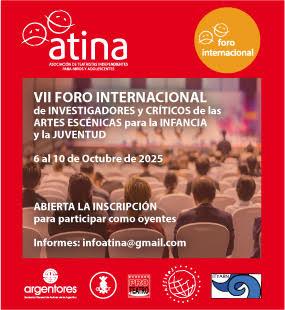ASSITEJ Project
From July 26-30 the 4th TYA Critics and Researchers International Forum took place in Buenos Aires organized by ATINA, AINCRIT and ITYARN on the topic “From Theatre for Babies to Theatre for Adolescents, is there a theatre for each target age?”
Researchers, artists and producers from Mexico, Brazil, Paraguay, Chile, Uruguay, Spain, Finland, Japan, USA and Argentina presented their papers, conferences and participated in debate panels. We want to thank our special guests Asaya Fujita, Katariina Metsälampi, Amauri Falseti, Enrique Olmos de Ita, Kenjiro Otani, Teresa Rotemberg, Sandra Mandoni, Gabriela Hilliar and Elsa Chapato for their participation in the Forum.
The conferences and presentations will be published soon but in the meantime we would like to share with you the Closing Remarks by Manon van de Water.
“I am honored to have both the opening speech of this 4th Forum of International Critics and Researchers in Theatre for Children and Youth, AND the closing remarks. I therefore had the chance to raise questions, see how these questions were addresses and played out, and now comment on that. Thus, the following has some observations, which, as in all good research, opens other avenues for debate so they are far from absolute conclusions.
I started my opening presentation, TYA in the 21st Century: What, How, and for Whom, with the notion that the definition of 20th Century TYA had been broadened on all levels, on WHAT we understand TYA might be in the 21st century in a move away from the written texts as starting point toward more hybrid performances; on HOW we make TYA and who makes it including many disciplines and artists from outside theatre per se; and, most importantly, WHOM TYA is for. I asserted that this broadening of definition makes for a more interesting, more diverse, and more inclusive landscape of theatrical experiences for a larger group of audiences.
The presentations, debates, roundtables, and productions over the past five days have confirmed that assertion. We have heard papers dealing with theatre for adolescents, theatre for young adults 18-25, theatre for children and youth with special needs, theatre for the very young, and, of course, theatre for babies.
Within these discussions some interesting patterns emerged. Few of the papers and presentations mentioned the mainstream audience of the 20th century, that is able, school aged students 6-12 years old. This audience is clearly a given in TYA and not in question. Some papers talked about adolescents, about 13-16 years old, as the forgotten age group. Fewer yet, tackled the young adult audience, roughly 17-25, although socio-neurological research proves that this is a distinct age group, that should be recognized, also by the Arts. Most presentations were about theatre for babies, which seems to be a target audience in Latin America that has been recently discovered as a group susceptible to theatre performances, and a group worthy of performance, although this is by no means uncontroversial.
So to start with baby theatre these are some main questions that need further research:
- Is it theatre? Is it aesthetic drama (that is, heightened dramatic play with children)? Does it by necessity need to be immersive?
- How do babies perceive theatre if they lack the necessary suspension of disbelief traditionally associated with performative arts?
- Does baby theatre foster a disposition to perceive aesthetically?
- If baby theatre is for a hybrid audience of parents and children, does it as much foster a habit in the parents of taking their children to the theatre at an older age, or, in effect, who is it for?
The problem with baby theatre, of course is that we cannot ask the audience. Traditional audience perception research does not work with babies, so most of our “findings,” if you want, rely on psychological research and child development, which is interesting but does not give the full picture. I would like to see a shift in focus on the aesthetic perception of babies and bring it back to the performative.
There was an interesting parallel in theatre for young adults and baby theatre, in that both involve the target audience in their productions. While in baby theatre this is immersive during the performance, theatre for young adults often involves the target audience in the creation process and in several instances the performances are presented by the youth as actors. In both baby theatre and young adult theatre, we, the adult audience, cannot escape, what I call “the gaze,” that is that we perceive the performance through looking at the babies and the young adults as actors/human beings in the production, vacillating between being themselves and performative agents. Which raises the notion of who this theatre is for: do babies perform for their fellow babies? Do teenagers who want to be heard perform for fellow teenagers? And I am not even talking about theatre with/by people with special needs which can also become highly problematic from a “gaze” perspective.
The boundaries are blurred and the research on performer, performing, performance text in the broader sense, and especially the audience has to continue. Dissemination of research is important, as it was shown by the influence of the book Theatre for the Early Years edited by Wolfgang Schneider. We need more research and make this available in more languages.
For now, and for this forum I would conclude this. No matter what age group we are working for, we need to connect with that age group, hear their stories, and then take these stories and tell them back. But not just like that. It is the artist who turns these stories into “art,” by giving it words, and visuals . . .using all artistic modes as well as the imagination to create the metaphors to tell these stories—metaphorically, artistically—back to the audience, and offer the audience a theatrical experience. And this responsibility of the artist is as important for babies, for young adults, for adolescents; for any age group”.
Manon van de Water





